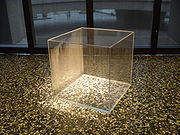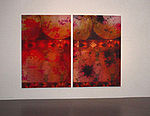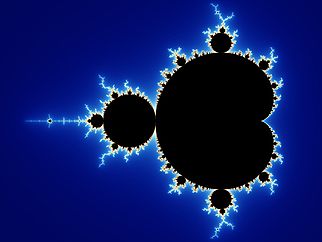
Generative art
Encyclopedia




Generative art refers to art
Art
Art is the product or process of deliberately arranging items in a way that influences and affects one or more of the senses, emotions, and intellect....
that has been generated, composed, or constructed in an algorithmic manner through the use of systems defined by computer
Computer
A computer is a programmable machine designed to sequentially and automatically carry out a sequence of arithmetic or logical operations. The particular sequence of operations can be changed readily, allowing the computer to solve more than one kind of problem...
software algorithms, or similar mathematical or mechanical or randomised autonomous processes.
Description
Generative art is a system oriented art practice where the common denominator is the use of systems as a production method. To meet the definition of generative art, an artwork must be self-contained and operate with some degree of autonomyAutonomy
Autonomy is a concept found in moral, political and bioethical philosophy. Within these contexts, it is the capacity of a rational individual to make an informed, un-coerced decision...
. The workings of systems in generative art might resemble, or rely on, various scientific theories such as Complexity science and Information theory
Information theory
Information theory is a branch of applied mathematics and electrical engineering involving the quantification of information. Information theory was developed by Claude E. Shannon to find fundamental limits on signal processing operations such as compressing data and on reliably storing and...
. The systems of generative artworks have many similarities with systems found in various areas of science. Such systems may exhibit order and/or disorder, as well as a varying degree of complexity, making behavioral prediction difficult. However, such systems still contain a defined relationship between cause and effect. Wolfgang Amadeus Mozart
Wolfgang Amadeus Mozart
Wolfgang Amadeus Mozart , baptismal name Johannes Chrysostomus Wolfgangus Theophilus Mozart , was a prolific and influential composer of the Classical era. He composed over 600 works, many acknowledged as pinnacles of symphonic, concertante, chamber, piano, operatic, and choral music...
's "Musikalisches Würfelspiel
Musikalisches Würfelspiel
A Musikalisches Würfelspiel was a system for using dice to randomly 'generate' music. These games were quite popular throughout Western Europe in the 18th century...
" (Musical Dice Game) 1757 is an early example of a generative system based on randomness. The structure was based on an element of order on one hand, and disorder on the other.
An artist or creator will usually set down certain ground-rules or formulae and/or templates materials, and will then set a random or semi-random process to work on those elements. The results will remain somewhat within set limits, but may also be subject to subtle or even startling mutations. The idea of putting the art making process in the place of a pre-generated artwork is a key feature in generative art, highlighting the process-orientation as an essential characteristic. Generative artists such as Hans Haacke
Hans Haacke
Hans Haacke is a German-American artist who lives and works in New York.- Early life :Haacke was born in Cologne, Germany. He studied at the Staatliche Werkakademie in Kassel, Germany, from 1956 to 1960. He was a student of Stanley William Hayter, a well-known and influential English printmaker,...
have explored processes of physical and biological systems in artistic context.
Generative art can also evolve in real-time, by applying feedback and generative processes to its own created states. A generative work of art would in this case never be seen to play in the same way twice. Different types of graphical programming environments (e.g. Max/Msp, Pure Data
Pure Data
Pure Data is a visual programming language developed by Miller Puckette in the 1990s for creating interactive computer music and multimedia works. While Puckette is the main author of the program, Pd is an open source project with a large developer base working on new extensions to it. It is...
or vvvv
Vvvv
vvvv is a general purpose toolkit with a special focus on real time video synthesis and programming large media environments with physical interfaces, real-time motion graphics, audio and video...
) as well as classic yet user-friendly programming environments such as Processing
Processing (programming language)
Processing is an open source programming language and integrated development environment built for the electronic arts and visual design communities with the purpose of teaching the basics of computer programming in a visual context, and to serve as the foundation for electronic sketchbooks...
or openFrameworks
OpenFrameworks
openFrameworks is an open source toolkit designed for "creative coding". OpenFrameworks is written in C++ and runs on Windows, Mac OS X, and Linux...
are used in real-time for generative audiovisual artistic expressions for instance in the Demoscene
Demoscene
The demoscene is a computer art subculture that specializes in producing demos, which are non-interactive audio-visual presentations that run in real-time on a computer...
and in VJ
VJ (video performance artist)
VJing is a broad designation for realtime visual performance. Characteristics of VJing are the creation or manipulation of imagery in realtime through technological mediation and for an audience, in synchronization to music. VJing often takes place at events such as concerts, nightclubs, music...
-culture.
Artificial intelligence
Artificial intelligence
Artificial intelligence is the intelligence of machines and the branch of computer science that aims to create it. AI textbooks define the field as "the study and design of intelligent agents" where an intelligent agent is a system that perceives its environment and takes actions that maximize its...
and automated behavior
Behavior
Behavior or behaviour refers to the actions and mannerisms made by organisms, systems, or artificial entities in conjunction with its environment, which includes the other systems or organisms around as well as the physical environment...
have introduced new ways of seeing generative art. The term behavior
Behavior
Behavior or behaviour refers to the actions and mannerisms made by organisms, systems, or artificial entities in conjunction with its environment, which includes the other systems or organisms around as well as the physical environment...
is particularly useful when describing generative qualities in art because of the associations to biology
Biology
Biology is a natural science concerned with the study of life and living organisms, including their structure, function, growth, origin, evolution, distribution, and taxonomy. Biology is a vast subject containing many subdivisions, topics, and disciplines...
and evolution
Evolution
Evolution is any change across successive generations in the heritable characteristics of biological populations. Evolutionary processes give rise to diversity at every level of biological organisation, including species, individual organisms and molecules such as DNA and proteins.Life on Earth...
, for example with the virus models used by the digital artist Joseph Nechvatal
Joseph Nechvatal
Joseph Nechvatal is a post-conceptual art digital artist and art theoretician who creates computer-assisted paintings and computer animations, often using custom-created computer viruses.-Life and work:Joseph Nechvatal was born in Chicago...
. Autopoiesis by Ken Rinaldo
Ken Rinaldo
Ken Rinaldo is an American artist and educator. He creates interactive art installations that explore the intersection between nature and technology...
includes fifteen musical and robotic sculptures that interact with the public and modify their behaviors based on both the presence of the participants and each other.
Another theme in generative art is the use of pre-existing databases as input. Mark Napier
Mark Napier (artist)
Mark Napier is an early pioneer of net.art in the United States, known for creating interactive online artwork that challenged traditional definitions of art...
was one of the pioneers in this area, creating works based on the streams of zeros and ones in ethernet traffic, as part of the "Carnivore" project. Martin Wattenberg
Martin M. Wattenberg
Martin M. Wattenberg is an American scientist and artist known for his work with data visualization. Along with Fernanda Viégas, he worked at the Cambridge location of IBM's Thomas J. Watson Research Center as part of the Visual Communication Lab, and created Many Eyes...
pushed this theme further, transforming "data sets" as diverse as musical scores (in "Shape of Song", 2001) and Wikipedia edits (History Flow, 2003, with Fernanda Viegas
Fernanda Viégas
Fernanda Bertini Viégas is a Brazilian scientist and designer whose work focuses on the social, collaborative, and artistic aspects of information visualization. Viégas received a Ph.D. in Media Arts and Sciences from the MIT Media Lab in 2005. The same year she began work at the Cambridge location...
) into dramatic visual compositions.
The term generative art does not describe any art-movement or ideology
Ideology
An ideology is a set of ideas that constitutes one's goals, expectations, and actions. An ideology can be thought of as a comprehensive vision, as a way of looking at things , as in common sense and several philosophical tendencies , or a set of ideas proposed by the dominant class of a society to...
. It's a method of making art. The term refers to how the art is made, and does not take into account why it was made or what the content of the artwork is.
Artworks, in generative art, can be identified in the creative processes and not only in the results. Also because the results of each generative process are endless variations belonging to the same idea. Generative Art create an artificial DNA
DNA
Deoxyribonucleic acid is a nucleic acid that contains the genetic instructions used in the development and functioning of all known living organisms . The DNA segments that carry this genetic information are called genes, but other DNA sequences have structural purposes, or are involved in...
able to generate individuals of the same species. In 1987 Celestino Soddu
Celestino Soddu
Celestino Soddu is an architect and professor of Generative Design at Politecnico di Milano university in Italy. He is one of the pioneers of Generative Art and Design...
created the artificial DNA of Italian Medieval towns able to generate endless 3D
3D computer graphics
3D computer graphics are graphics that use a three-dimensional representation of geometric data that is stored in the computer for the purposes of performing calculations and rendering 2D images...
models of cities identifiable as belonging to the idea.
Examples
Composers such as John CageJohn Cage
John Milton Cage Jr. was an American composer, music theorist, writer, philosopher and artist. A pioneer of indeterminacy in music, electroacoustic music, and non-standard use of musical instruments, Cage was one of the leading figures of the post-war avant-garde...
and Brian Eno
Brian Eno
Brian Peter George St. John le Baptiste de la Salle Eno , commonly known as Brian Eno or simply as Eno , is an English musician, composer, record producer, singer and visual artist, known as one of the principal innovators of ambient music.Eno studied at Colchester Institute art school in Essex,...
have used generative principles and systems in their works. Cut-up technique
Cut-up technique
The cut-up technique is an aleatory literary technique in which a text is cut up and rearranged to create a new text. Most commonly, cut-ups are used to offer a non-linear alternative to traditional reading and writing....
by Tristan Tzara
Tristan Tzara
Tristan Tzara was a Romanian and French avant-garde poet, essayist and performance artist. Also active as a journalist, playwright, literary and art critic, composer and film director, he was known best for being one of the founders and central figures of the anti-establishment Dada movement...
and William Burroughs, AARON
AARON
AARON is a software program written by artist Harold Cohen that creates original artistic images.Proceeding from Cohen's initial question "What are the minimum conditions under which a set of marks functions as an image?", AARON has been in continual development since 1973...
, John Horton Conway
John Horton Conway
John Horton Conway is a prolific mathematician active in the theory of finite groups, knot theory, number theory, combinatorial game theory and coding theory...
's Conway's Game of Life
Conway's Game of Life
The Game of Life, also known simply as Life, is a cellular automaton devised by the British mathematician John Horton Conway in 1970....
, visual software by Scott Draves
Scott Draves
Scott Draves is the inventor of Fractal Flames and the leader of the distributed computing project Electric Sheep. He also invented patch-based texture synthesis and published the first implementation of this class of algorithms...
and Karl Sims
Karl Sims
Karl Sims is a computer graphics artist and researcher, who is best known for using particle systems and artificial life in computer animation....
, interactive installations by Maurizio Bolognini
Maurizio Bolognini
Maurizio Bolognini is an Italian post-conceptual artist. His installations explore the potential and implications of new media technologies starting from the minimal and abstract activation of processes that are beyond artist's control, at the crossroads between generative art, public art and...
, sculptures by Anne Wilson
Anne Wilson (artist)
Anne Wilson is a Chicago-based visual artist. Wilson creates sculpture, drawings, Internet projects, photography, performance, and DVD stop motion animations employing table linens, bed sheets, human hair, lace, thread and wire. Her work extends the traditional processes of Fiber art to other media...
, artwork by Sol LeWitt
Sol LeWitt
Solomon "Sol" LeWitt was an American artist linked to various movements, including Conceptual art and Minimalism....
, software art by Adrian Ward and architectures by Celestino Soddu are examples of generative art in different disciplines.
See also
- Algorithmic artAlgorithmic artAlgorithmic art, also known as algorithm art, is art, mostly visual art, of which the design is generated by an algorithm. Algorithmic artists are sometimes called algorists.- Overview :...
- ArtmediaArtmediaArtmedia, Seminar and Laboratory of the Aesthetics of Media and Communication, was one of the first scientific projects concerning the relationship between art, technology, philosophy and aesthetics. It was founded in 1985 at the University of Salerno...
- Computer artComputer artComputer art is any art in which computers play a role in production or display of the artwork. Such art can be an image, sound, animation, video, CD-ROM, DVD-ROM, videogame, web site, algorithm, performance or gallery installation...
- Conway's Game of LifeConway's Game of LifeThe Game of Life, also known simply as Life, is a cellular automaton devised by the British mathematician John Horton Conway in 1970....
- Digital morphogenesisDigital morphogenesisDigital morphogenesis is a process of shape development enabled by computation. While this concept is applicable in many areas, the term "digital morphogenesis" is used primarily in architecture....
- Dynamic PaintingDynamic PaintingDynamic painting is a movement in visual arts where paintings are updated on an on-going basis. The artist determines the general principles for image genesis and develops algorithms for transformation methods...
- Evolutionary artEvolutionary artEvolutionary art is created using a computer. The process starts by having a population of many randomly generated individual representations of artworks. Each representation is evaluated for its aesthetic value and given a fitness score...
- Generative musicGenerative musicGenerative music is a term popularized by Brian Eno to describe music that is ever-different and changing, and that is created by a system.- Theory :There are four primary perspectives on "Generative Music" Generative music is a term popularized by Brian Eno to describe music that is ever-different...
- Generative systemsGenerative systemsGenerative systems are systems that use a few basic rules to yield patterns. Depending on the rules, the patterns can be extremely varied and unpredictable. One of the more well-known examples is Conway's Game of Life, a cellular automaton. Another example is Boids...
- Immersion (virtual reality)Immersion (virtual reality)Immersion is the state of consciousness where an immersant's awareness of physical self is diminished or lost by being surrounded in an engrossing total environment; often artificial. This mental state is frequently accompanied with spatial excess, intense focus, a distorted sense of time, and...
- Interactive artInteractive artInteractive art is a form of installation-based art that involves the spectator in a way that allows the art to achieve its purpose. Some installations achieve this by letting the observer or visitor "walk" in, on, and around them; Some others ask the artist to become part of the artwork.Works of...
- New media artNew media artNew media art is a genre that encompasses artworks created with new media technologies, including digital art, computer graphics, computer animation, virtual art, Internet art, interactive art, computer robotics, and art as biotechnology...
- Software artSoftware artSoftware art refers to works of art where the creation of software, or concepts from software, play an important role; for example software applications which were created by artists and which were intended as artworks. As an artistic discipline software art has attained growing attention since the...
- Systems artSystems artSystems art is art influenced by cybernetics, and systems theory, which reflects on natural systems, social systems and social signs of the art world itself....
- Systems theorySystems theorySystems theory is the transdisciplinary study of systems in general, with the goal of elucidating principles that can be applied to all types of systems at all nesting levels in all fields of research...
- Virtual artVirtual artVirtual art is art practice using virtual reality, augmented reality or mixed reality as a medium in a digital environment..-Form:It can be considered a post-convergent art form, containing all previous media as subsets...
External links
- Generative Art wiki
- Generator.x. A conference and exhibition on software and generative strategies in art and design.
- Generative Art International Conference. A yearly event in Milan, Italy.
- generative.net. A collaborative collection of artworks, research and experiments, with mailing list discussion.
- Playing with Time. A conversation between Will Wright and Brian Eno on generative creation.

